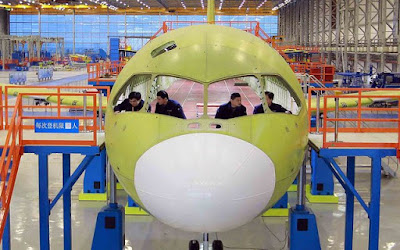Final assembly work on the Comac C919 has kicked into high gear, with assembly of the first prototype airframe almost complete.
Pictures released to Flightglobal show an almost complete airframe joined from nose through to the tail. Wing-to-body join has also been done, with the vertical and horizontal stabilisers already attached to the aircraft's tail.
The aircraft is still resting on struts, although the main landing gear and forward landing gear appear to have been installed. The aircraft's wingtip devices have also yet to be installed. No other aircraft are pictured in the final assembly centre area.
A Comac spokesman tells Flightglobal that no systems have been installed on the aircraft.
Over the last six months the Chinese aircraft manufacturer has been taking delivery of the jet's major structures, with final assembly work officially started last September.
Comac has publicly stated end-2015 as the aircraft's first flight target, and the spokesman says the goal remains to strive towards that timeline.
He adds however that major works such as the installation of the avionics, flight control and hydraulics systems still remain to be done. The various systems also have to be integrated and tested.
Tests are however ongoing at full-swing on the C919 iron bird test rig, with more than 50 test engineers and technicians involved.
An official on the indigenous Chinese programme told Flightglobal last September that the iron bird is scheduled to undergo two cycles of tests before the C919's first flight.
Delays on the aircraft's first flight are however expected since system integration will be complex for Comac, another official says.
Comac has so far secured 450 commitments for the in-development narrowbody from 18 companies, most of which are local airlines and leasing firms.
Pictures released to Flightglobal show an almost complete airframe joined from nose through to the tail. Wing-to-body join has also been done, with the vertical and horizontal stabilisers already attached to the aircraft's tail.
The aircraft is still resting on struts, although the main landing gear and forward landing gear appear to have been installed. The aircraft's wingtip devices have also yet to be installed. No other aircraft are pictured in the final assembly centre area.
A Comac spokesman tells Flightglobal that no systems have been installed on the aircraft.
Over the last six months the Chinese aircraft manufacturer has been taking delivery of the jet's major structures, with final assembly work officially started last September.
 |
| Comac C919 |
He adds however that major works such as the installation of the avionics, flight control and hydraulics systems still remain to be done. The various systems also have to be integrated and tested.
Tests are however ongoing at full-swing on the C919 iron bird test rig, with more than 50 test engineers and technicians involved.
 |
| Comac C919 |
An official on the indigenous Chinese programme told Flightglobal last September that the iron bird is scheduled to undergo two cycles of tests before the C919's first flight.
Delays on the aircraft's first flight are however expected since system integration will be complex for Comac, another official says.
Comac has so far secured 450 commitments for the in-development narrowbody from 18 companies, most of which are local airlines and leasing firms.




No comments:
Post a Comment